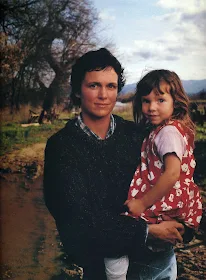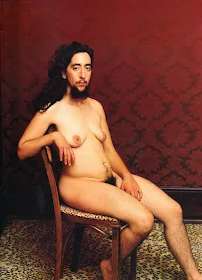The photographs by
Annie Leibovitz in Women, taken especially for the book, encompass a broad
spectrum of subjects: a rap artist, an astronaut, two Supreme Court justices,
farmers, coal miners, movie stars, showgirls, rodeo riders, socialites,
reporters, dancers, a maid, a general, a surgeon, the First Lady of the United
States, the secretary of state, a senator, rock stars, prostitutes, teachers,
singers, athletes, poets, writers, painters, musicians, theater directors,
political activists, performance artists, and businesswomen. "Each of
these pictures must stand on its own," Susan Sontag writes in the essay
that accompanies the portraits. "But the ensemble says, So this what women
are now -- as different, as varied, as heroic, as forlorn, as conventional, as
unconventional as this."
Το
1999 με το βιβλίο και την έκθεση «Women», για το οποίο την προέτρεψε η συγγραφέας και πολιτισμική
αναλύτρια Σούζαν Σόνταγκ, κατέγραψε την
γυναίκα στην Αμερική. Μια παρέλαση και ένα σχόλιο για τα κοινωνικά στρώματα από
τα κορίτσια στα σόου του Λας Βέγκας μέχρι την Πρώτη Κυρία. Ήταν ένα συλλογικό
πορτρέτο της Αμερικανίδας εκείνη την εποχή. Η Λίμποβιτς έχει πλήρη επίγνωση του
πόσο πλούσιο μπορεί να είναι ένα τέτοιο θέμα και το παρομοιάζει με το να
φωτογραφίζει κάποιος έναν ωκεανό.
Εκείνη
και η Susan Sontag δούλεψαν μαζί για να «συντάξουν» την πινακοθήκη των
«Γυναικών», ένα θέμα που όπως έλεγε η Σόντανγκ ήταν διαρκώς εν εξελίξει, μια
ιστορία εν δυνάμει. Μια «δουλειά που όνειρό της ήταν να ολοκληρώσει με το
πορτρέτο της Άντζελα Μέρκελ».
Συνόψισε
το νόημα αυτής της δουλειάς μέσα από ένα ανέκδοτο: η κόρη μιας χορεύτριας
σχολίασε βλέποντας τις λήψεις; «Μαμά, όταν μεγαλώσω, θέλω να γίνω γυναίκα».
Andrea Medina
Rosas, women’s rights lawyer, Chimalhuacán, Mexico, 2016. Her mother is a
feminist who founded a women’s rights organization when Andrea was a teenager.
The first woman who came to them for help was a victim of domestic violence.
That was the beginning of Andrea’s involvement in the defense of victims of
sexual violence and also the protection of their defenders. The watershed event
for Mexican feminists of Andrea’s generation was the recognition, starting in
the early 1990s, that hundreds, perhaps thousands, of young women in and near
Ciudad Juárez, across the border from El Paso, were being abducted, tortured,
and murdered. Andrea was a member of the litigating team in what became known
as the Campo Algodonero case, which was brought before the Inter-American Court
of Human Rights in 2007. Campo Algodonero is an abandoned cotton field in
Ciudad Juárez where the bodies of eight young women were found. The case was
brought against the government of Mexico for violating its human rights
obligations to investigate, prosecute, and prevent crimes against women and
girls. In 2009, the plaintiffs won. The Mexican state was required to comply
with a broad set of remedial measures, including reopening investigations into
disappearances, providing reparations to the families of victims, and
developing a clear set of procedures for assuring human rights for women.
Andrea was photographed in the municipality of Chimalhuacán, which is part of
the greater Mexico City urban area. She is standing near a spot where pink crosses
are erected to memorialize the murdered women whose bodies have been found
there. Photo: Courtesy of
Annie Leibovitz
Denise and
Linamandla Manong, pediatric-AIDS health-care worker and her daughter,
Khayelitsha township, Western Cape, South Africa, 2014. A grassroots,
African-based organization called mothers2mothers is having great success
reducing the number of babies born HIV positive. Denise is living with HIV, but
her children are not. When she became pregnant and discovered that she was
infected with the virus, she was put on a drug-treatment regimen that kept her
healthy and prevented the transmission of HIV to her baby. A Mentor Mother, a
local woman who was also HIV positive and who was employed and trained by
mothers2mothers, supplied the support and advice that overburdened health-care
facilities could not. After the birth of her daughter, Denise herself became
one of more than 1,000 Mentor Mothers in sub-Saharan Africa who have helped to
virtually eliminate HIV in babies born in the mothers2mothers program. Photo:
Courtesy of Annie Leibovitz
Patti Smith,
musician, writer, artist, Far Rockaway, Queens, New York, 2016. She has been
making music and art since the early 1970s, when she stood in front of her band
in skinny jeans and a ripped T-shirt, giving ecstatic, charismatic, profane
performances that merged poetry and rock ’n’ roll. Downtown New York clubs were
her natural milieu, but in 1975 she made an album for a major record label.
This was Horses, which is now pretty unanimously considered one of the greatest
rock albums of all time. In the cover photograph, taken by her friend Robert
Mapplethorpe, she gazes out insolently, her black jacket tossed over the
shoulder of a white man’s shirt. She has had only one Top 40 hit—“Because the
Night”—in a long career, but her influence has been significant, on fashion as
well as music. She has been inducted into the Rock and Roll Hall of Fame and
won the 2010 National Book Award for Just Kids, a memoir of her relationship
with Mapplethorpe. For the fortieth anniversary of Horses, she and the band
performed live versions around the world. Photo:
Courtesy of Annie Leibovitz
Alexandra Fuller,
writer, Kelly, Wyoming, 2016. She grew up in what was then Rhodesia—later
Zimbabwe—in the 1970s, during the brutal civil war that ended in the defeat of
the white government. Fuller’s parents were British farmers who stayed in
Africa after they lost their land. When she was in her early 20s, she married
an American who was working as a river guide on the Zambezi River. They moved
to Wyoming, where she raised three children and began writing. Her books, which
include the memoirs Don’t Let’s Go to the Dogs Tonight (2001)
and Cocktail Hour Under the Tree of Forgetfulness (2011), take
a precise and personal approach to issues such as racism and segregation. She
is an uninhibited witness, both wry and poetic in her account of a childhood in
which spitting cobras in the pantry, malaria, alcoholism, and land mines were
taken for granted, along with the fierce beauty of the country and the complex
passions of her eccentric mother and father. Photo: Courtesy of Annie Leibovitz
Πηγές:
http://www.andro.gr/empneusi/annie-leibovitz/
- https://www.vogue.com/slideshow/annie-leibovitz-photos-women-portraits#1

















































































Δεν υπάρχουν σχόλια:
Δημοσίευση σχολίου